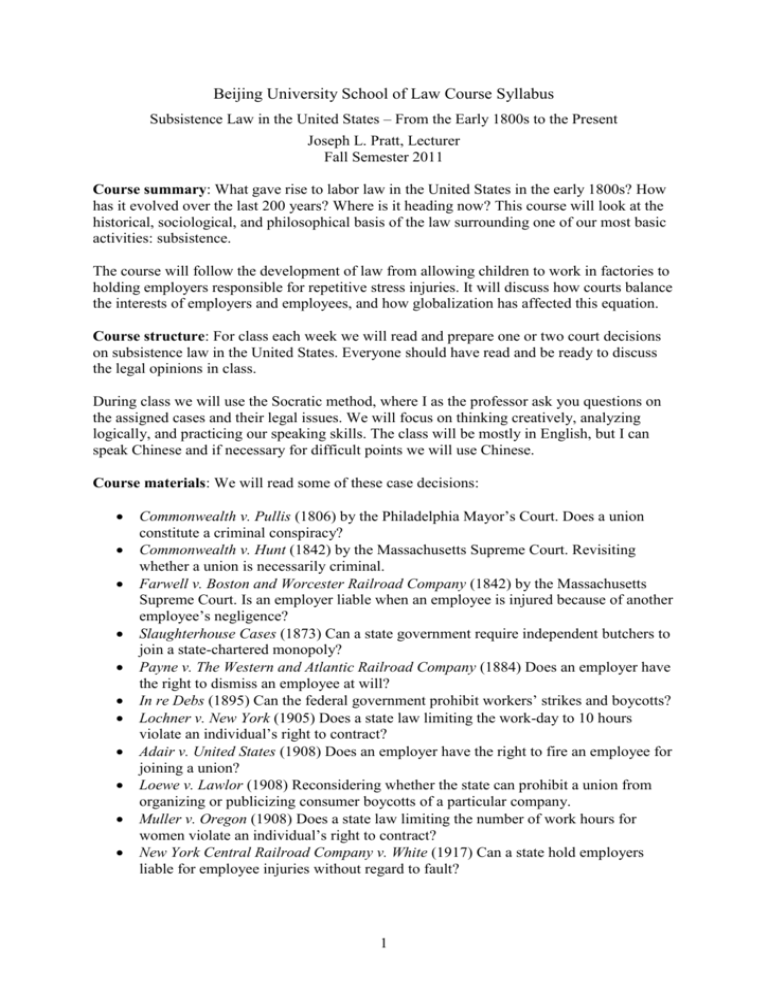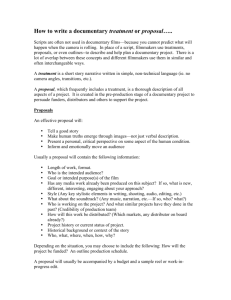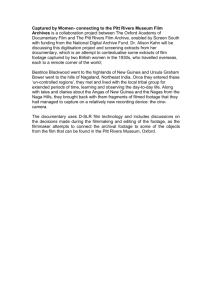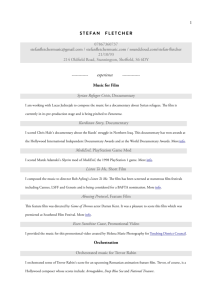American Labor Law
advertisement

Beijing University School of Law Course Syllabus Subsistence Law in the United States – From the Early 1800s to the Present Joseph L. Pratt, Lecturer Fall Semester 2011 Course summary: What gave rise to labor law in the United States in the early 1800s? How has it evolved over the last 200 years? Where is it heading now? This course will look at the historical, sociological, and philosophical basis of the law surrounding one of our most basic activities: subsistence. The course will follow the development of law from allowing children to work in factories to holding employers responsible for repetitive stress injuries. It will discuss how courts balance the interests of employers and employees, and how globalization has affected this equation. Course structure: For class each week we will read and prepare one or two court decisions on subsistence law in the United States. Everyone should have read and be ready to discuss the legal opinions in class. During class we will use the Socratic method, where I as the professor ask you questions on the assigned cases and their legal issues. We will focus on thinking creatively, analyzing logically, and practicing our speaking skills. The class will be mostly in English, but I can speak Chinese and if necessary for difficult points we will use Chinese. Course materials: We will read some of these case decisions: Commonwealth v. Pullis (1806) by the Philadelphia Mayor’s Court. Does a union constitute a criminal conspiracy? Commonwealth v. Hunt (1842) by the Massachusetts Supreme Court. Revisiting whether a union is necessarily criminal. Farwell v. Boston and Worcester Railroad Company (1842) by the Massachusetts Supreme Court. Is an employer liable when an employee is injured because of another employee’s negligence? Slaughterhouse Cases (1873) Can a state government require independent butchers to join a state-chartered monopoly? Payne v. The Western and Atlantic Railroad Company (1884) Does an employer have the right to dismiss an employee at will? In re Debs (1895) Can the federal government prohibit workers’ strikes and boycotts? Lochner v. New York (1905) Does a state law limiting the work-day to 10 hours violate an individual’s right to contract? Adair v. United States (1908) Does an employer have the right to fire an employee for joining a union? Loewe v. Lawlor (1908) Reconsidering whether the state can prohibit a union from organizing or publicizing consumer boycotts of a particular company. Muller v. Oregon (1908) Does a state law limiting the number of work hours for women violate an individual’s right to contract? New York Central Railroad Company v. White (1917) Can a state hold employers liable for employee injuries without regard to fault? 1 Hammer v. Dagenhart (1918) and Bailey v. Drexel Furniture Company (1922) Can the federal government prohibit goods made through child labor from entering interstate commerce or do the same thing through its power of taxation? Adkins v. Children’s Hospital (1923), Morehead v. New York ex rel. Tipaldo (1936), and West Coast Hotel v. Parrish (1937) Does a minimum wage law violate an individual’s right to contract? National Labor Relations Board v. Jones and Laughlin Steel Company (1937) Can the federal government forbid a company from firing an employee for organizing a union? Lauf v. E. G. Shinner (1938) Can the federal government prohibit the federal courts from issuing an injunction to prevent nonviolent strikes, picketing, or boycotts? Hague v. Congress of Industrial Organizations (1939) Does a municipality have the right to control meetings and the distribution of literature in public places? Thornhill v. Alabama (1940) Does a union have the right to picket a company? Steele v. Louisville and Nashville Railroad Company (1944) Can a labor union exclude black people from its membership? Youngstown Sheet and Tube Co. v. Sawyer (1952) Can the President in an emergency seize a private company to prevent its workers from striking? Griggs v. Duke Power Company (1971) Can a private company require an employee to meet certain requirements if those requirements are not related to a job’s skill set and unfairly discriminate against a minority group? McDonnell Douglas Corporation v. Green (1973) What is an employee’s burden of proof to claim disparate treatment? Dothard v. Rawlinson (1977) Can a state prison screen security guard applicants based on their height, weight, and gender? Sheets v. Teddy’s Frosted Foods Inc. (1980) Can a company fire an employee if the employee notifies management that it is producing substandard food products and violating labeling laws? Wilson v. Southwest Airlines (1981) Does a private airline have the right to hire only female flight attendants? United Airlines v. McDonald (1986) Can a private business dismiss a woman for getting married? Meritor Savings Bank v. Vinson (1986) Is a hostile work environment a form of unlawful gender discrimination? Gasioch v. Stroh Brewery Company (1986) Is a brewery that provides free beer to its employees during regular breaks liable when an employee becomes a chronic alcoholic? Price-Waterhouse v. Hopkins (1989) Does sexual-stereotyping constitute a form of discrimination? Automobile Workers v. Johnson Controls (1991) Can a company require a woman to be sterilized before working in an area where she would be exposed to high levels of lead? Lechmere, Inc. v. National Labor Relations Board (1992) Can an employer prevent union organizers from soliciting workers on the employer’s property? Harris v. Forklift Systems (1993) Do workplace protections extend to hostile and abusive workplace environments? Toyota Manufacturing, Kentucky, Inc. v. Williams (2002) Does a physical impairment which only limits certain work-related activities constitute a compensable workplace disability? 2 Northfolk and Western Railroad v. Ayers (2003) Is an employer liable for pain and suffering caused by a fear of cancer (that has not yet been contracted)? Spencer v. Tyson Foods (2004) By the Court of Appeals of the State of Mississippi. Does a repetitive stress injury constitute a workplace injury? Witt v. Department of the Air Force (2008) by the United States Court of Appeals for the Ninth Circuit. Can the United States Air Force dismiss a service member for being a homosexual? Hopkins v. Uninsured Employers Fund (2011) by the Supreme Court of Montana. Does marijuana use bar an injured employee from collecting workers’ compensation? I will provide you with abridged editions of these cases. All of the above legal decisions, unless otherwise noted, are from the United States Supreme Court. Additional course materials: In addition to these cases, we will read newspaper articles and legislation related to this area of law. These materials will provide historical context for the legal decisions, and now include the following: Teacher’s Essay: Early Industrialization (1998) at http://invention.smithsonian.org. Economic Growth and the Early Industrial Revolution (2011) at www.ushistory.org. The First American Factories (2011) at www.ushistory.org. The Impact of the Industrial Revolution on Families in New England & America (2010) by Nicole Smith at www.articlemyriad.com. The Triangle Shirtwaist Factory Fire Trial (2002) by Douglas O Linder at http://law2.umkc.edu/faculty/projects/ftrials/triangle/trianglefire.html. Triangle Shirtwaist Factory Fire Remembered in NYC at www.huffingtonpost.com. 1914: The Ludlow Massacre at http://libcom.org/history/articles/ludlow-massacre1914. Eyewitness to Murder: Recounting the Ludlow Massacre (1914) by Godfrey Irwin at http://historymatters.gmu.edu/d/5737/. Occupational Safety and Health Act and Workers’ Compensation articles at www.wikipedia.org (for a history of workplace safety law in the United States). Wisconsin Budget Repair Bill (2011) This is a recent state law to remove the right of public workers to bargain collectively. What Do Wisconsin Protests Say About Organized Labor (2011) by Paul Solman at www.pbs.org. Optional movies: In addition to legal opinions and other materials, outside of class we will view films that provide additional historical context on this area of the law. These movies may include: Germinal (1993) About a coalminers’ strike in northern France in the 1860s. It was the most expensive film ever made in France at the time and won French National Film Awards for Best Cinematography and Best Costume Design. American Experience: Triangle Fire (2011) The story of the Triangle Shirtwaist Factory Fire which claimed the lives of 148 young female workers at a textile factory in New York City in 1911. This fire prompted a nationwide debate on the rights of factory workers. 3 Matewan (1987) About a coalminers’ strike and effort to unionize in a small West Virginia town in 1920. It also addresses the relationship between white and black replacement miners during this period. Grapes of Wrath (1940) The story of an Oklahoma family who loses their farm and ends up as migrant workers in California during the Great Depression in the 1930s. This movie was based on the Pulitzer Prize winning novel by John Steinbeck and won Academy Awards for Directing and Best Supporting Actress. The Uprising of 1934 (1995) About a general textile workers strike that was violently put down in the southern United States in 1934. This documentary features testimony from survivors of the strike, often given for the first time publicly. This work won numerous film festival awards. On the Waterfront (1954) A drama about violence and corruption among waterfront union members in New York City during the late 1940s. This film was based on true stories and received eight Academy Awards, including Best Actor for Marlon Brando as dockworker Terry Malloy. Harlan County, USA (1976) This documentary describes a bloody strike by 180 coal miners and their wives against a Duke company coal mine in Kentucky in 1973. This film was directed by Barbara Kopple and won an Academy Award for Best Documentary Feature. Norma Rae (1979) The real-life story of a cotton mill worker who joins an effort to unionize her factory. Actress Sallie Field, who portrays Norma Rae Webster, won an Academy Award for Best Actress and the Cannes Film Festival Best Actress Award. American Dream (1990) This documentary recounts a strike by meatpackers against Hormel Foods in Minnesota in 1985 and 1986. This film, directed also by Barbara Kopple, won an Academy Award for Best Documentary Feature. Roger & Me (1989) This documentary focuses on the closure of several automobile factories in the city of Flint, Michigan, in the 1980s. The name ‘Roger’ stands for Roger Smith, who was CEO of General Motors at that time, while ‘Me’ stands for Michael Moore, who grew up in Flint, Michigan, and directed the documentary. Capitalism: A Love Story (2009) This documentary examines the U.S. financial crisis from 2007 to 2010. It takes a critical look at the current American economic order and capitalism in general. Michael Moore again directed this film and won a Venice Film Festival award for it. Grading: Your grade will be based on your class attendance and participation (20-30%), short writing assignments in English (20-30%), and a final examination covering the assigned cases and ongoing legal and philosophical questions concerning this area of law (50%). If your class participation and writing assignment grades differ, the higher grade will count as 30% of your final grade, while the lower mark will count as 20%. If your class participation and writing assignment grades are the same, that grade will be half your total. About the instructor: I graduated with honors from Northwestern University School of Law in 2000. Since that time I have worked for three years at the law firm of Sidley Austin and several years at a small technology start-up. Over the past seven years I have also travelled extensively around China and India, and recently finished two pieces of philosophical writing. I’m currently working on a third piece of writing and looking forward to this class, especially the chance to explore the philosophical and sociological aspects of this law. 4





